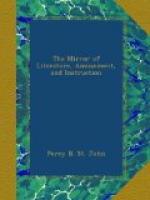Among the Italians and the French even there have been found enemies to dancing. Alfieri, the poet, had a great aversion to dancing; and one Daneau wrote a Traite des Danses, in which he maintains that “the devil never invented a more effectual way than dancing, to fill the world with ——.” The bishop of Noyon once presided at some deliberations respecting a minuet; and in 1770, a reverend prelate presented a document on dancing to the king of France. The Quakers consider dancing below the dignity of the Christian character; and an enthusiast, of another creed, thinks all lovers of the stage belong to the schools of Voltaire and Hume, and that dancing is a link in the chain of seduction. Stupid, leaden-heeled people, who constantly mope in melancholy, and neither enjoy nor impart pleasure, will naturally be enemies to dancing; and such we are induced to think the majority of these opponents.
The French are inveterate dancers. They have their bals pares and their salons de danse in every street; and as long as the weather will permit, they dance on platforms out of doors, and a heavy shower of rain will scarcely cool their ardour in the recreation. Some of their stage figurantes resemble aerial beings rather than bone and blood, for flesh may almost be left out of the composition. But the Italians are a nation of dancers as well as the children of song, and they seem to have followed the noble example of old Cato, in this respect, with better effect than they have studied his virtue. We are also told upon good authority, that the American dancers equal any of the European figurantes.
The English people have always been lovers of dancing; and it forms an accompaniment of almost all their old sports and pastimes. Witness the maypoles, wassails, and wakes of rural life, and the grotesque morris-dance, originating in a kind of Pyrrhic or military dance, and described by Sir William Temple as composed of “ten men, who danced a maid marian and a tabor and pipe.” In the time of Henry VII. dancers were remarkably well paid; for in some of his accounts in the Exchequer, we find
L. s. d. Paid to a spye, in reward----------------- 2 0 0 To Pechie, the fool, in rewarde----------- 0 6 8 To Richard Beden, for writing of bokes—— 0 10 0 To the young dameysell that daunceth—— 30 0 0
In Shakspeare’s time, to dance was an elegant accomplishment. Thus in the “Merry Wives of Windsor,” “What say you to young Mr. Fenton? He capers, he dances, he has eyes of youth, he writes verses.” Locke thus alludes to the graceful motions which dancing lends to the human frame: “the legs of the dancing-master, and the fingers of a musician, fall, as it were, naturally, without thought or pains, into regular and admirable motions.”




